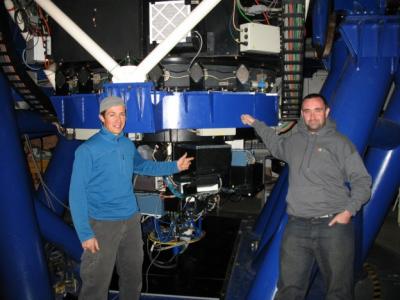By Kalwinder KaurAug 31 2012
During this week, a supernovae target was robotically achieved by the recently installed two identical FLOYDS spectrographs, at telescopes 6,000 mies apart.
 Matt Dubberley, Lead Engineer, (left) and David Sand, Lead Astronomer stand beside Faulkes Telescope North and the new FLOYDS spectrograph. Credit: LCOGT
Matt Dubberley, Lead Engineer, (left) and David Sand, Lead Astronomer stand beside Faulkes Telescope North and the new FLOYDS spectrograph. Credit: LCOGT
With unique integration of design, competence, and level of automation, the FLOYDS spectrographs got their name from the band Pink Floyd for their album artwork on The Dark Side of the Moon that demonstrates dispersal of white light into the colors of the rainbow using a prism. FLOYDS creates rainbows from distant supernova explosions instead of sunlight. In addition, the gamma ray bursts out for investigating their inner workings and chemical compositions.
Mounted on Faulkes Telescope North (FTN) at Haleakala Observatory and on Faulkes Telescope South (FTS) at Siding Spring Observatory, FLOYDS are among the first spectrographs that were created to achieve astronomical targets, observe the targets and process the information without involving on-site astronomers. Telescopes can rapidly support on-target studies.
With increasing use of robotic imaging telescopes in astronomy, robotic spectrographs are seldom constructed for ground-based observatories. One reason is the spectrograph opens through a narrow slit, the starlight falling through the slit needs pointing the telescope to over two-tenths of an arcsecond and this is a challenging task. On the other hand, the spectrographs can effectively observe the entire visible spectrum within a single exposure.
Majority of spectrographs need two exposures to visualize over such a wide range, FLOYDS can make two-fold increase in the range it captures. Light focused on the spectrograph hits a diffraction grating, dispersing the light into a spectrum. Two radiant frequencies share each diffraction angle. In order to attain an unmuddied spectrum, most spectrographs can filter higher or lower spectrum, exiting half the range. FLOYDS supplements a prism, the higher frequency spectrum’s location will be optimized to a different location on the digital camera, followed by capture of a wider range of colors.
A team from Las Cumbres Observatory Global Telescope (LCOGT) comprising lead mechanical engineer Matt Dubberley, astronomer David Sand, telescope technicians Mark Elphick and Mark Willis has achieved the installation of the spectrographs in June and July.
Robotic spectrographs such as FLOYDS can be programmed for automatic observation of targets from a sky survey, thereby stopping other telescope observations. By placing two spectrographs on the globe’s opposite sides, observation following a supernova explosion can be enhanced and better achieved.
Disclaimer: The views expressed here are those of the author expressed in their private capacity and do not necessarily represent the views of AZoM.com Limited T/A AZoNetwork the owner and operator of this website. This disclaimer forms part of the Terms and conditions of use of this website.